Editor’s Note: This is the 20th in a series of stories researched during Don and Nancy Harrison’s 50th Wedding Anniversary cruise from Sydney, Australia, to San Diego. Previous installments of the series, which runs every Thursday, may be found by tapping the number of the installment: 1, 2, 3, 4, 5, 6, 7, 8, 9, 10, 11, 12, 13, 14, 15, 16, 17, 18, 19
By Donald H. Harrison
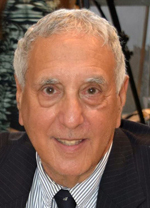
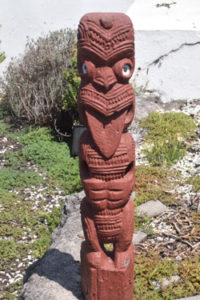
WHAKAREWAREWA, New Zealand – There are a few rituals at this Maori village in the vicinity of Rotorua, New Zealand, in which there are strict differentiation for men and women.
For example, carvings of faces that appear on the outside of homes may only represent males. Female faces appear only on the inside of the homes. The reason, according to our Maori guide Paora Tapsell, whose first name is Maori and whose surname is that of a Danish ancestor, is because “the male is on the outside for protection.”
A visitor might be hard-put to tell the gender represented by the carvings. However, unlike males, females never stick out their tongues – the traditional gesture and act of defiance that typifies the haka, the Maori’s famous war dance, which along with other dances was performed for visitors to the village.
The carvings tell stories about the families who live in the village. Traditionally, Maori was an unwritten language, so traditions and genealogies were passed from generation to generation through the media of song, storytelling, and carvings.
In traditional Maori belief, the head is the most sacred part of the body. One kind of carving shows a man with two tongues. “This represents the high priest,” explained Tapsell. One of the high priest’s tongues is to speak to the physical world; the other to speak to the spiritual world. “He was the only gentleman who was allowed to mark the people’s faces; no one else was allowed to mark the face.”
There is a traditional Polynesian greeting known as a honi, in which women briefly press their foreheads to those of other women, and men greet each other in similar fashion while inhaling each other’s breath. Otherwise, it is taboo for observant Maoris to touch each other’s faces. “No rubbing of noses like our Eskimo brothers,” cautions Tapsell, and “no head-butting, and definitely no kissing!”
Carvings often have etchings on one side of the face, indicating the father’s genealogy, and on the other side for the mother’s. The subject’s accomplishments are illustrated from the eyelids down; knowledge is celebrated from the eyelids up.
Whakarewarewa is known as a thermal village because of its location in an area of active geysers and deep, hot mineral pools. The village’s name actually was shortened from its original moniker, which was Whakarewarewatanga O Te Ope Taua A Wahiao, which translates to “The Gathering Place of the Army of Wahiao.”
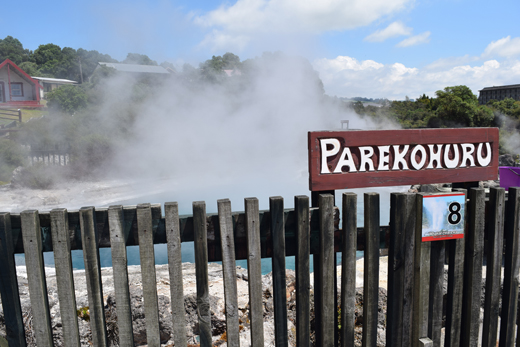
In one of the pools, nicknamed the “Champagne Pool” because bubbles rise to its surface, vegetables are cooked by lowering them in a pot into the water. Corn is cooked in 10 minutes; cabbage takes 2 to 3 minutes; broccoli and cauliflower, 3-4 minutes, soft eggs 6 minutes, and hardboiled eggs, a little longer. Meat is never placed in this pool “because the fat content of the meat will contaminate the water,” Tapsell tells us. But don’t get the idea that this pool is kosher pareve. It’s okay to cook crayfish and lobsters here, generally for about five minutes each. What is a forbidden food for observant Jews is a delicacy for the Maori. The same is true of pork, which is cooked in pots at a different pool.
The champagne pool, also named Parekohuru, which translates as “Murderous Ripples,” has no known bottom. At the surface its temperature is approximately 100 degrees Centigrade (212 degrees Fahrenheit); and the farther down one goes, the hotter it gets, with measurements up to 285 degrees Centigrade (545 degrees Fahrenheit). As one might imagine, children are strictly prohibited from going near the fenced-off pools.
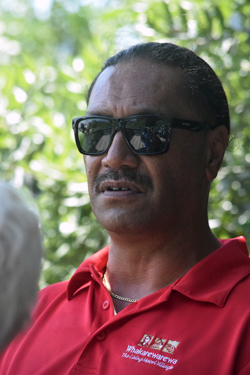
The boiling, steaming waters are channeled to a communal bath, which some Maori take at sunrise, others at sunset, and still others under the starry skies. Women change inside a bathhouse, men outside. Where the waters are allowed to cool to tolerable temperatures, the rocks around the bathing pools are covered with minerals of different colors: yellow from sulfur; white from calcium; gray from silica; reddish brown from copper or iron; and pink from cinnabar. “The baths have therapeutic qualities, good for aching joints and soreness,” according to our guide. “When people hop out of the bath they are cleaner and soothed. The baths are cleaned every day … It is a golden rule, the last one out pulls the plug, so we are not bathing in everybody’s water. We have a fresh clean bath all the time.”
Meat and poultry are cooked at another pool. In the old days, these entrees might have been placed into flax woven baskets, or a muslin cloth, but today aluminum foil or even plastic bags are used. These wrapped foods are placed together in a large box, able to hold enough food for approximately 45 families or 200 people. “It is a wet heat, what better way to avoid doing dishes?” jokes Tapsell. “The longer you keep food in the boxes, the more tender it becomes. It is like a slow cooker for casseroles, stews, soups… It separates meat from the bones.”
Jews sometime like to joke that chrain, the horseradish that we dip our gefilte fish into, is “Jewish Dristan” because it can clear up the sinuses. The Maori have a far more dramatic helper for that — another pool at the village that is called Korotiotio, which translates to “grumpy old man.” Hot water sometimes explodes from Korotiotio. Villagers walk by it when they want to clear their sinuses or their hay fever. “When you inhale it clears up the nasal passages, and at the same time it gives you a facial, and it does steam up your glasses and camera lenses,” says Tapsell. He recommended that we inhale the steam through our nostrils and exhale it through our mouths.
One can drop turkey, duck, and pheasants in this super-heated pool, count to five, and take them out. Care to cook five kilograms of rice? Just leave the pot in the water for five minutes.
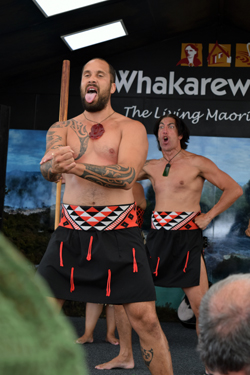
Whakarewarewa is adjacent to the largest geysers in New Zealand, which are under the supervision of the New Zealand government, not the indigenous people who were their traditional caretakers. This is a sore point with the local Maori who see it as an infringement upon their traditional ways. The three geysers located a short distance from each other are Pohutu; Prince of Wales; and Kereru; the middle one named in honor of a visit by a British royal in the early 20th century. Pohutu is the largest geyser, “when it reaches full eruption, it can reach a height of 30 meters (98+ feet).” The geysers used to erupt every hour to 90 minutes, but since the 2001 eruption of Mount Etna in Italy, there has been movement of tectonic plates, and “we get 4 or 5 eruptions an hour. On some occasions, they spray throughout the day, so we don’t get to see a full eruption.”
While the geysers are a boon for tourism, they also indicate that this is an area of heavy seismic activity. The village sits at the bottom of an 18-kilometer (11-mile) fault line. A government hotel nearby was closed because cracks appeared under it. “We went hurrah because they shouldn’t have been here,” said Tapsell.
However, he said, “In the event of a chain reaction, if you see me running, you better be following me!”
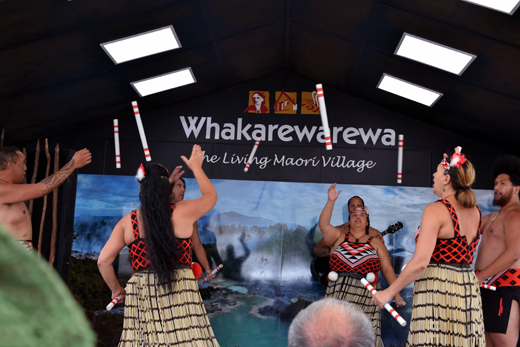
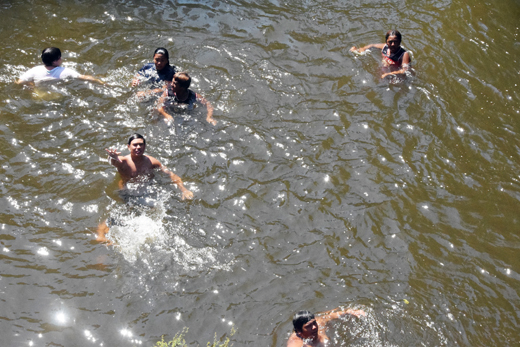
On the day we visited the village, there seemed to be very little concern on that score. Adult energy wasn’t expended in running, but rather in the Te Pakira troupe’s performances of the haka and other ceremonial dances for the visitors. As for the children, they were happily diving for coins from an 1885 bridge near the entrance to the village.
*
Harrison is editor of San Diego Jewish World. He may be contacted via donald.harrison@sdjewishworld.com
Pingback: Movies at sea enhance the cruise | San Diego Jewish World
Pingback: The peace treaty that started a nation but left a dispute | San Diego Jewish World